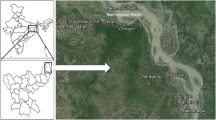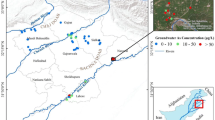Abstract
The experiment was conducted to assess the impact of arsenic (As)-contaminated groundwater irrigation on soil health and crop quality. Geo-referenced groundwater, soil, and crop produce samples were collected from the middle Gangetic plains of Maner block of Patna and were analyzed for As content. The result showed that long-term application of As-contaminated groundwater (0.017 to 0.677 mg L−1) buildup significant amount of As in the soil (0.41 to 8.66 mg kg−1). A significant correlation (r2 = 0.922) was also observed between As content in groundwater and the soil. The content of As in groundwater also affected crop quality and accumulated metal content in different crop parts. Total As content in crop samples ranged from 0.010 to 0.963 μg g−1 of dry weight. The average As content in crop followed order: oilseeds > cereals > vegetables > pulses. Therefore, produce quality should be monitored frequently for As uptake as there is a great chance of As accumulation in food crops. Hence, these approaches are useful for the formulation of policy guidelines for the management of As-containing groundwater and routine risk assessment of As-contaminated soils.




Similar content being viewed by others
References
Abedin, M. J., Cresser, M. S., Meharg, A. A., Feldmann, J., & Cotter-Howells, J. (2002). Arsenic accumulation and metabolism in rice (Oryza sativa L.). Environmental Science & Technology, 36, 962–968.
Bhattacharya, P., Samal, A. C., Majumdar, J., & Santra, S. C. (2009a). Transfer of arsenic from groundwater and paddy soil to rice plant (Oryza sativa L): A micro level study in West Bengal, India. World Journal of Agricultural Sciences, 5, 425–431.
Bhattacharya, P., Samal, A. C., Majumdar, J., & Santra, S. C. (2009b). Accumulation of arsenic and its distribution in rice plant (Oryza sativa L.) in Gangetic West Bengal, India. Paddy and Water Environment, 8(1), 63–70.
Bhattacharya, P., Samal, A. C., Majumder, J., & Santra, S. C. (2010). Arsenic contamination in rice, wheat, pulses and vegetables: A study in an arsenic affected area of West Bengal, India. Water, Air, and Soil Pollution, 213, 3–13.
Biswas, A., Deb, D., Ghose, A., Santra, S. C., & Mazumder, D. N. G. (2014). Seasonal perspective of dietary arsenic consumption and urine arsenic in an endemic population. Environmental Monitoring and Assessment, 186, 4543–4551.
Chakraborti, D., Mukherjee, S. C., Pati, S., Sengupta, M. K., Rahman, M. M., Chowdhury, U. K., Lodh, D., Chanda, C. R., Chakraborti, A. K., & Basu, G. K. (2003). Arsenic groundwater contamination in middle ganga plain, Bihar, India: A future danger? Environmental Health Perspectives, 111(9), 1194–1201.
Dahal, B. M., Fuerhacker, M., Mentler, A., Karki, K. B., Shrestha, R. R., & Blum, W. E. H. (2008). Arsenic contamination of soils and agricultural plants through irrigation water in Nepal. Environmental Pollution, 155, 157–163.
Dotaniya, M. L., Meena, V. D., & Das, H. (2014). Chromium toxicity on seed germination, root elongation and coleoptile growth of pigeon pea (Cajanus cajan). Legume Research, 37(2), 225–227.
Dotaniya, M. L., Rajendiran, S., Meena, V. D., Saha, J. K., Coumar, M. V., Kundu, S., & Patra, A. K. (2016). Influence of chromium contamination on carbon mineralization and enzymatic activities in vertisol. Agricultural Research, 6(1), 91–96.
Dotaniya, M. L., Meena, V. D., Rajendiran, S., Coumar, M. V., Saha, J. K., Kundu, S., & Patra, A. K. (2017). Geo-accumulation indices of heavy metals in soil and groundwater of Kanpur, India under long term irrigation of tannery effluent. Bulletin of Environmental Contamination and Toxicology, 98, 706–711.
Dotaniya, M. L., Rajendiran, S., Meena, V. D., Coumar, M. V., Saha, J. K., Kundu, S., & Patra, A. K. (2018). Impact of long-term application of sewage on soil and crop quality in vertisols of Central India. Bulletin of Environmental Contamination and Toxicology, 101, 779–786.
FAO (1985) Water quality guidelines for maximum crop production. FAO/UN. www.fao.org/docrep/T0551E. Accessed 13 Jun 2017.
Gomez, K. A., & Gomez, A. (1983). Statistical procedures for agricultural research. New York: Wiley.
Hossain, M. A., Mukherjee, A., Sengupta, M. K., Ahmad, S., Das, B., Nayak, B., Pal, A., Rahman, M. M., & Chakraborti, D. (2006). Million-dollar arsenic removal plants in West Bengal, India: Useful or not? Water Quality Research Journal of Canada, 41, 216–225.
Huang, R. Q., Gao, S. F., Wang, W. L., Staunton, S., & Wang, G. (2006). Soil arsenic availability and the transfer of soil arsenic to crops in suburban areas in Fujian Province, Southeast China. Science of the Total Environment, 368, 531–541.
Kar, S., Das, S., Jean, J. S., Chakraborty, S., & Liu, C. C. (2013). Arsenic in the water-soil-plant system and the potential health risks in the coastal part of Chianan plain, southwestern Taiwan. Journal of Asian Earth Sciences, 77, 295–302.
Page, A. L., Miller, R. H., & Keeney, D. R. (1982). Methods of soil analysis. Part 1 and 2. Madison: Am Soc Agron, Soil Sci Soc Am Inc.
Phan, K., Sthiannopkao, S., Kim, K. W., Wong, M. H., Sao, V., Hashim, J. H., Mohamed-Yasin, M. S., & Aljunid, S. M. (2010). Health risk assessment of inorganic arsenic intake of Cambodia residents through groundwater drinking pathway. Water Research, 44, 5777–5788.
Postma, D., Larsen, F., Hue, N. T. M., Duc, M. T., Viet, P. H., Nhan, P. Q., & Jessen, S. (2007). Arsenic in groundwater of the Red River floodplain, Vietnam: Controlling geochemical processes and reactive transport modeling. Geochimica et Cosmochimica Acta, 71, 5054–5071.
Rajendiran, S., Dotaniya, M. L., Coumar, M. V., Panwar, N. R., & Saha, J. K. (2015). Heavy metal polluted soils in India: Status and countermeasures. JNKVV Research Journal, 49(3), 320–337.
Saha, D., Sahu, S., & Chandra, P. (2011). Arsenic-safe alternate aquifers and their hydraulic characteristics in contaminated areas of middle ganga plain, eastern India. Environmental Monitoring and Assessment, 175, 331–348.
Saha, J. K., Rajendiran, S., Coumar, M. V., Dotaniya, M. L., Kundu, S., & Patra, A. K. (2017). Agriculture, soil and environment. In Soil pollution - an emerging threat to agriculture. Singapore: Springer.
Sandhi, A., Landberg, T., & Greger M. (2017). Phytofiltration of arsenic by aquatic moss (Warnstorfia fluitans). Environmental Pollution, 237, 1098–1105.
Singh, S. K. (2015). Groundwater arsenic contamination in the middle-Gangetic plain, Bihar (India): The danger arrived. International Research Journal of Environmental Sciences, 4, 70–76.
Singh, S. K., & Ghosh, A. K. (2011). Entry of arsenic into food material–a case study. World Applied Sciences Journal, 13, 385–390.
Singh, S. K., & Ghosh, A. K. (2012). Health risk assessment due to groundwater arsenic contamination: Children are at high risk. Human and Ecological Risk Assessment, 18, 751–766.
Singh, S. K., & Vedwan, N. (2015). Mapping composite vulnerability to groundwater arsenic contamination: An analytical framework and a case study in India. Natural Hazards, 75, 1883–1908.
Singh, S. K., Ghosh, A. K., Kumar, A., Kislay, K., Kumar, C., Tiwari, R., Parwez, R., Kumar, N., & Imam, M. (2014). Groundwater arsenic contamination and associated health risks in Bihar, India. International Journal of Environmental Research, 8, 49–60.
USEPA. (2001). National primary drinking water regulations: Arsenic and clarifications to compliance and new source contaminants monitoring. Federal Register, 40(9), 141–142.
WHO (2007) Joint FAO/WHO expert standards program codex alimentation commission, Geneva. http://www.who.int. Accessed April 13, 2020.
Acknowledgments
Authors are highly thankful to Dr. G.L. Meena, Scientist, ICAR-Indian Institute of Soil & Water Conservation, Research Centre, Kota for the preparation of the Geo-referenced map.
Author information
Authors and Affiliations
Corresponding author
Ethics declarations
Conflict of interest
The authors declare that they have no conflict of interest.
Additional information
Publisher’s note
Springer Nature remains neutral with regard to jurisdictional claims in published maps and institutional affiliations.
Rights and permissions
About this article
Cite this article
Meena, M.K., Singh, A.K., Prasad, L.K. et al. Impact of arsenic-polluted groundwater on soil and produce quality: a food chain study. Environ Monit Assess 192, 785 (2020). https://doi.org/10.1007/s10661-020-08770-9
Received:
Accepted:
Published:
DOI: https://doi.org/10.1007/s10661-020-08770-9




